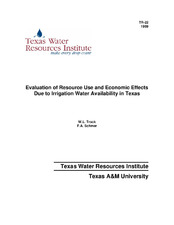| dc.creator | Trock, W. L. | |
| dc.creator | Schmer, F. A. | |
| dc.date.accessioned | 2011-06-30T16:54:56Z | |
| dc.date.available | 2011-06-30T16:54:56Z | |
| dc.date.issued | 1969-08 | |
| dc.identifier.uri | https://hdl.handle.net/1969.1/94864 | |
| dc.description.abstract | The State of Texas has been actively developing a State Water Plan which is to become a basic guide for water development in Texas through the year 2020. The availability of water to agriculture in the future and its effect on the Texas economy is of utmost importance to Texans.
Potential agricultural resource requirements are dependent on numerous and diverse factors. Some of these factors are known and measurable such as the water needs of growing plants. Other factors are unknown and remain subject to conjecture. Future agricultural price and production control programs are unknown and can only be hypothesized. These factors and others are important to water requirements of agriculture and must be dealt with by measurement or estimation.
This research was initiated to develop meaningful projections of agricultural water requirements which would be useful in planning for water resource development. Five different models of agricultural resource requirements and production were analyzed. Each model contains: (1) restrictions on production and marketing of products, (2) assumptions relative to resource availability and use, and (3) estimates of output with the specified use of resources. These models illustrate to the water resource planner the potential of Texas agriculture to produce food and fiber as well as the effects of various restrictions on production. These restrictions include some factors which cannot be controlled, such as market limitations. The models include various assumptions concerning water supply for agriculture and the effects of these assumptions are evident in the results of the analysis.
The results of these models present to the water resource planner the effect on Texas agriculture of alternative allocations of water to agriculture. The procedures and computer programs developed can evaluate for the planner an infinite number of alternatives. Comparison of alternative availability of water to agriculture provides a basis for evaluation of the economic benefit from the allocation of water to agriculture. | en |
| dc.language.iso | en_US | |
| dc.publisher | Texas Water Resources Institute | |
| dc.relation.ispartofseries | TR;22 | |
| dc.title | Evaluation of Resource Use and Economic Effects Due to Irrigation Water Availiability in Texas | en |
| dc.type | Technical Report | en |


